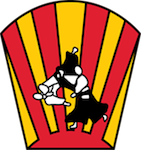History
Many fighting systems developed in Japan during its feudal era - the use of the lance, sword, staff, archery, hand-to-hand combat, and many more. Systems of unarmed combat became known as jiu jitsu (also spelled ju jitsu, or ju jutsu). Jiu jitsu techniques involved throwing, locking, striking, choking, and pinning, and the defences to these and all manner of weapons. Because these techniques were designed for combatants wearing armour, the large leaping and kicking movements found in many other arts were not used in jiu jitsu.
During the 12th century, the Emperor was overthrown and approximately 400 years of civil war followed. During this time, jiu jitsu was continually tested and refined on the battlefield. Although jiu jitsu techniques had been used for centuries, it was during the Edo period (1603 - 1868) that jiu jitsu developed into a systematic art taught by numbers of masters, with over 700 different schools at the height of its popularity.
However, in 1873, the government brought the rigid social structure to an end and prohibited the Samurai from wearing swords in public. Many Samurai resisted this legislation and although they were eventually suppressed, their resistance seriously damaged the reputation of the martial arts. This, together with sweeping social changes in Japan, led to a vast decline in the popularity of jiu jitsu, although the recent offshoots of Judo and Aikido began to gain in popularity.
After World War II, the occupation forces prohibited the practice of the martial arts and this ban was not revoked until 1951. Many jiu jitsu practitioners left Japan at this time and began introducing their art to the western world.
One of his earliest students was Brian Graham, who was amongst the first of Komp Shihan's students to achieve the rank of black belt in jiu jitsu and judo. On his return to England, Graham Shihan founded the style Shorinji Kan Jiu Jitsu, and this name has been kept to the present day. Graham Shihan was the founder and head of style for Shorinji Kan Jiu Jitsu and sadly he passed away in June 2005.
A number of instructors have moved from the UK to other countries and opened clubs, including Andy Dobie who moved to Canada in September 1993 and founded clubs in Peterborough and Ottawa, Ontario. More recently, instructors have founded in the U.S.A., Buenos Aires, Holland, Australia, and New Zealand, placing Shorinji Kan Jiu Jitsu at an international level.
During the 12th century, the Emperor was overthrown and approximately 400 years of civil war followed. During this time, jiu jitsu was continually tested and refined on the battlefield. Although jiu jitsu techniques had been used for centuries, it was during the Edo period (1603 - 1868) that jiu jitsu developed into a systematic art taught by numbers of masters, with over 700 different schools at the height of its popularity.
However, in 1873, the government brought the rigid social structure to an end and prohibited the Samurai from wearing swords in public. Many Samurai resisted this legislation and although they were eventually suppressed, their resistance seriously damaged the reputation of the martial arts. This, together with sweeping social changes in Japan, led to a vast decline in the popularity of jiu jitsu, although the recent offshoots of Judo and Aikido began to gain in popularity.
After World War II, the occupation forces prohibited the practice of the martial arts and this ban was not revoked until 1951. Many jiu jitsu practitioners left Japan at this time and began introducing their art to the western world.
Shorinji Kan Jiu Jitsu
The origins of our style are hard to trace. Matthew Komp began his martial arts study in the 1940's when he took up wrestling. After joining the police force in Germany, he began to study judo and jiu jitsu as part of his police self-defence training. His first jiu jitsu instructor was Alfred Hassemeier. Komp also studied karate, aikido and taekwon-do, and has had a number of instructors from Japan, Germany and Korea. From these influences, Komp formed his style of jiu jitsu which he took to Australia in the 1950's, where he founded a school in Footscray, near Melbourne.One of his earliest students was Brian Graham, who was amongst the first of Komp Shihan's students to achieve the rank of black belt in jiu jitsu and judo. On his return to England, Graham Shihan founded the style Shorinji Kan Jiu Jitsu, and this name has been kept to the present day. Graham Shihan was the founder and head of style for Shorinji Kan Jiu Jitsu and sadly he passed away in June 2005.
A number of instructors have moved from the UK to other countries and opened clubs, including Andy Dobie who moved to Canada in September 1993 and founded clubs in Peterborough and Ottawa, Ontario. More recently, instructors have founded in the U.S.A., Buenos Aires, Holland, Australia, and New Zealand, placing Shorinji Kan Jiu Jitsu at an international level.
